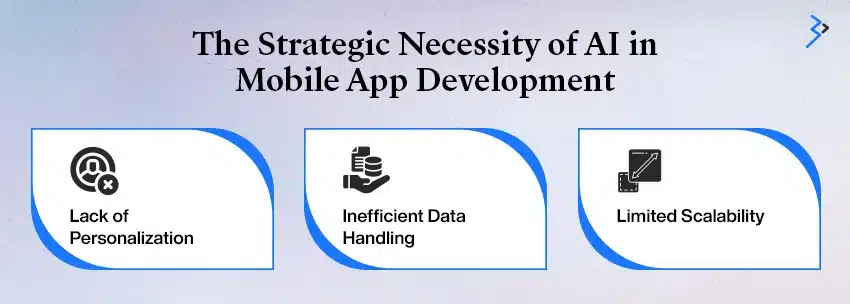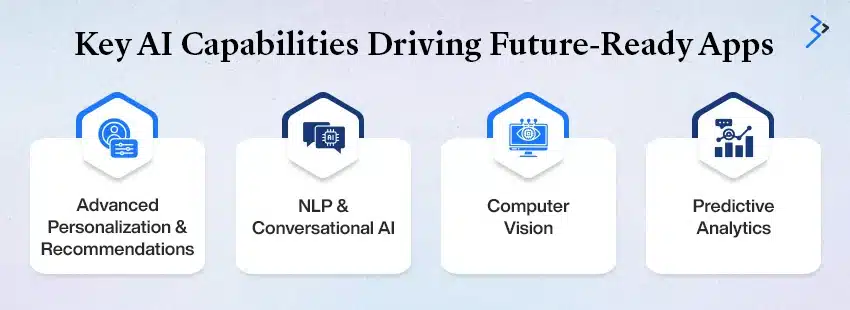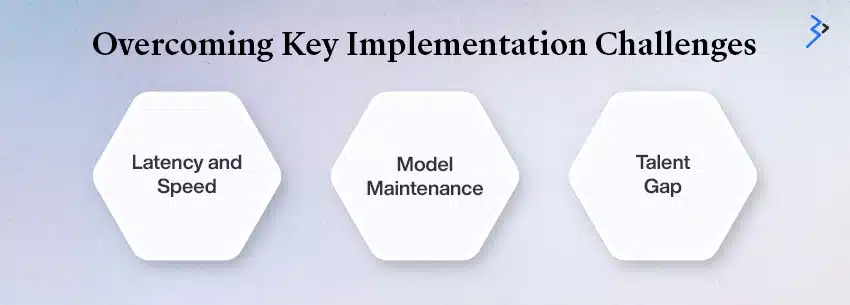The era of simplistic mobile apps has passed. Today’s users expect their apps not simply to function, but to learn, adapt, and serve as personalized companions, powered by advanced artificial intelligence. Integrating AI into mobile applications has therefore become essential for any digital product that seeks to stand out and sustain user engagement.
For instance, imagine an eCommerce app development that anticipates your next purchase based on your shopping habits or a fitness application that dynamically adjusts your workout plan by analysing your real-time heart rate and activity metrics. These are not hypothetical visions but increasingly realistic use cases as AI becomes embedded in mobile experiences.
According to a report by Market.us, the global AI in Mobile Apps market is valued at around US $21.23 billion in 2024 and is expected to reach nearly US $354.09 billion by 2034. This growth reflects a strong compound annual growth rate (CAGR) of 32.5% over the forecast period.
According to TechCrunch, citing data from Sensor Tower, generative-AI mobile apps generated over $1.1 billion in global consumer spending in 2024, marking a 240% year-over-year increase.
The Strategic Necessity of AI in Mobile App Development

Why are companies prioritizing the integration of AI? Simply put, AI provides a potent competitive edge by enhancing the three pillars of a successful app: User Experience (UX), Operational Efficiency, and Data-Driven Decision Making.
The market clearly reflects the urgency to act. According to projections by Statista, the global AI market is expected to surge to roughly US$826.7 billion by 2030, growing at a compound annual rate of 27.67%. Companies that fail to leverage AI risk creating outdated and unresponsive apps compared to their smart counterparts.

The Problem with Traditional Apps
Traditional mobile app development often results in transactional but not transformational features.
- Lack of Personalization: Static interfaces treat all users similarly, leading to low engagement and high churn rates.
- Inefficient Data Handling: Vast amounts of user data are collected but not used in real-time to adjust the application’s function or interface.
- Limited Scalability: Manual updates are required for new features or user segment changes, making the app slow to adapt to market shifts.
Key AI Capabilities Driving Future-Ready Apps

Integrating AI in mobile app development unlocks powerful functionalities, transforming user interaction and operational efficiency. These capabilities move the app from a passive database to an active intelligence partner.
1. Advanced Personalization and Recommendation Engines
The most evident application of artificial intelligence is its visibility. By analyzing historical behavior, demographics, and real-time context (like location or time of day), AI algorithms can tailor content, products, and features to individual users.
According to the New America Foundation, Netflix’s recommendation system is a significant contributor to its revenue generation model, driving approximately 80 percent of hours of content streamed on the platform.
2. Natural Language Processing (NLP) and Conversational AI
NLP helps apps understand, interpret, and generate human language. This capability is the foundation for highly effective AI-powered mobile apps and is crucial for:
- Intelligent Chatbots: Providing instant, human-like customer support, scheduling, or sales assistance directly within the app.
- Voice Assistants: Enabling hands-free navigation and interaction with the application’s features.
3. Computer Vision
This technology enables mobile apps to “see” and interpret images and videos. Practical applications include:
- Visual Search: Letting a user snap a photo of a shoe and instantly find that product, or similar ones, in an e-commerce catalog.
- Augmented Reality (AR) Filters: Enhancing user-generated content and marketing campaigns through face recognition and real-time environment mapping.
4. Predictive Analytics
AI uses machine learning models to forecast future user actions, maintenance needs, or market outcomes. For mobile app development, this means:
- Predicting user churn risk so the app can proactively offer loyalty rewards or re-engagement campaigns.
- Forecasting infrastructure load during peak usage times to ensure stability and seamless performance.
The Strategic Steps for Building an AI-Powered Mobile App

Integrating AI is a strategic business decision, not just a technical add-on. It requires careful planning and a phased implementation approach.
Phase 1 | Defining the AI Strategy and Use Case
The first step in any AI in mobile app development project is defining a clear business problem that AI can solve. Avoid simply adding AI for novelty.
- Identify the Pain Point (or Opportunity)
Determine where AI can deliver the maximum impact: Is it reducing customer service costs, increasing average order value, or improving user retention?
- Data Readiness Assessment
Developers create artificial intelligence using data as a foundation. You must determine if your organization has the necessary volume, variety, and data quality. Assessing data storage, security, and governance standards is essential. A successful AI model relies on clean, labeled data.
- Select the Core AI Module
Choose the specific SAP-HCM component or machine learning model based on your pain point. For instance, if the goal is customer retention, focus on a Classification Model; if the goal is visual product search, focus on a Computer Vision API.
Phase 2 | Data Acquisition and Engineering
This phase is the heavy lifting, as it involves preparing the necessary fuel for the AI engine.
- Data Collection and Cleansing
Gather data from various sources (user actions, transactional history, third-party APIs) and rigorously clean it. The process involves removing noise, handling missing values, and standardizing formats.
- Feature Engineering
Transforming raw data into meaningful features that the machine learning model can use to learn. This step is critical for model accuracy and performance.
- Building the Secure Data Pipeline
Establishing a robust and compliant infrastructure to feed data securely to the mobile app’s back-end systems. Data security and privacy (especially compliance with GDPR or CCPA) must be non-negotiable foundations for the data pipeline.
Phase 3 | Model Development and Training
The AI model is built and refined during this core technical phase.
- Choosing the Right Algorithm
Selecting the appropriate machine learning algorithm (e.g., neural networks for computer vision, decision trees for predictive analytics) based on the project’s goal.
- Model Training and Validation
Feeding the prepared data to the model and iteratively training it. Validation involves testing the model against a separate data set to ensure it generalizes well and isn’t just memorizing the training set. A high-performing model requires rigorous tuning of its hyperparameters.
- Iterative Refinement
Model development is never a “one-and-done” process. It requires continuous loops of testing, analyzing error rates, and retraining the model to increase its precision.
Phase 4 | Mobile App Integration and Deployment
Seamless integration defines a truly future-ready app. The model must function quickly in a mobile environment.
- Edge vs. Cloud Deployment
Decide whether the model will run directly on the user’s device (Edge Deployment) or on a remote server (Cloud Deployment).
Edge: Faster response time, works offline, and has better privacy. Ideal for simple tasks like basic face recognition.
Cloud: Greater computational power, easier model updates. Suitable for complex tasks like visual search or heavy NLP.
- API Integration
Exposing the trained AI model as a reliable, low-latency API endpoint. The mobile app development team then integrates these APIs into the native app code (iOS/Android).
- User Experience Testing
We are testing the user flow to ensure the AI integration feels intuitive and non-intrusive. The AI should be helpful, not confusing or irritating.
Overcoming Key Implementation Challenges

While the potential of mobile app development meets AI is enormous, real-world implementation presents specific technical hurdles.
- Latency and Speed: Mobile users expect instant responses. If the AI model requires heavy processing in the cloud, latency can ruin the UX. Solutions involve optimizing the model size and using high-speed edge computing.
- Model Maintenance: AI models degrade over time as real-world data shifts (model drift). A dedicated MLOps (Machine Learning Operations) pipeline is essential for continuously monitoring, retraining, and deploying updated models.
- Talent Gap: Integrating AI requires highly specialized skills in data science, MLOps, and scalable cloud architecture, skills often difficult for in-house teams to acquire.
Conclusion: Partnering for a Smarter Digital Future
For competitive businesses, developing an AI-powered app is essential. Embracing new technologies requires rethinking data management, app design, and user experience to enhance personalization and efficiency. To navigate data management and app integration challenges, you need a partner with expertise in cloud technology and mobile solutions.
At Brainvire, we combine our extensive experience in mobile app development with advanced data science and MLOps practices. We help organizations create innovative applications that enhance customer interactions and deliver significant business results, preparing you for a prosperous digital future.
FAQs:-
AI enables apps to learn from user behavior and preferences, delivering smarter, context-aware interactions. For instance, an AI-powered eCommerce app can predict what users might buy next or auto-adjust recommendations based on real-time activity, creating a seamless, personalized experience that feels human.
Start by defining a clear business goal, not a technology goal. Whether it’s reducing churn, improving personalization, or automating customer support, align AI use cases with measurable outcomes. This ensures your investment in AI directly supports business growth.
Yes, AI can be integrated into existing mobile apps without a complete rebuild. Companies can enhance existing app functionality through API-based AI services, such as predictive analytics, chatbots, or visual search modules, while minimizing disruption and cost.
AI models need continuous learning. Businesses must implement MLOps pipelines to retrain and update models as user data evolves, preventing “model drift.” Regular testing and feedback loops ensure the app’s AI stays relevant, accurate, and high-performing.
Building an AI-powered app involves complex data pipelines, cloud infrastructure, and user experience optimization. A partner like Brainvire, with deep expertise in AI, data science, and mobile app development, helps accelerate delivery, minimize risk, and unlock maximum ROI.
Related Articles
-
How Mobile Applications Are Game-Changing For Insurers?
Well said, Most of us forget to take our wallet, but not the mobile phones.” Mobile phones have become an integral part of our lives and its number is growing
-
5 Ways To Upsurge M-Commerce App Downloads
For retailers, selling to the customers where they spend most of the time is the way to get in the fast lane. It’s the universal truth that needs no explanation!
-
App Store Optimization (ASO) is important for the success of your Mobile app
With Android application development you can build phenomenal apps. Same goes for other mobile platforms. But what good is an app if it gets lost in the existing maze of




